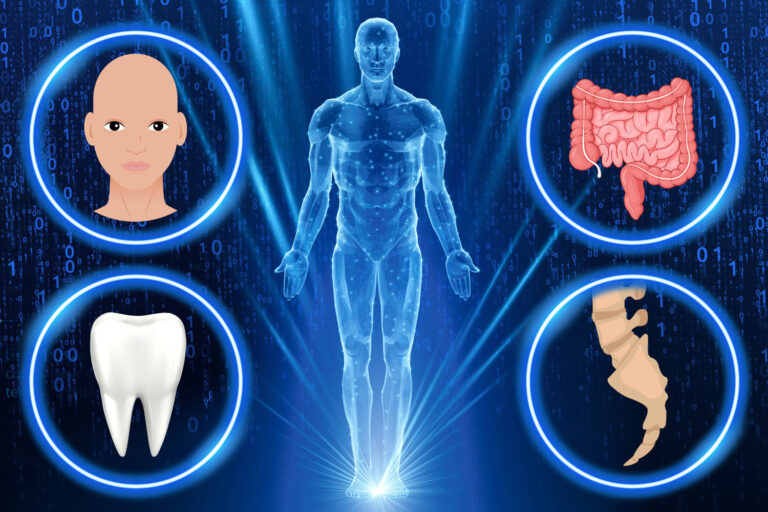SCIENTISTS warn that future humans may go hairless and even lose four other body parts due to the way we live today.
Experts say that changes in diet, technology, and environment could drive these drastic evolutionary shifts over thousands of years.

7

7
Traits that were once essential for survival, like body hair or certain organs, may become redundant, gradually disappearing from the human body.
Researchers are particularly focused on how modern comforts, reduced physical activity, and medical advances could reshape our anatomy in ways previously only seen in evolutionary theory.
Yes — the human body is an incredible machine, vital for life, but some features that were once essential now serve little to no purpose.
Here are five body parts that are slowly disappearing.
Hair

7
Body hair once served vital functions like warmth and protection.
But today, it’s often removed for aesthetic reasons.
Apart from eyelashes and eyebrows, hair removal has become a standard grooming practice, especially among women.
A study found that over 90% of women in the UK typically remove their armpit and leg hair, with many also removing substantial portions of their pubic hair.
This trend is largely driven by societal norms and beauty standards.
As a result, hair has become a lot finer and sparser.
Now largely cosmetic and slowly fading, scientists predict that humans may continue to lose body hair.
Modern clothing, heated homes, and technological comforts also mean natural insulation is no longer vital.
So, body hair may become even more finer, sparser or even disappear entirely.
Wisdom teeth

7
Wisdom teeth, or third molars, originally helped our ancestors grind down tough, raw foods like roots, nuts, and uncooked meat.
But modern cooking and softer diets mean most of us no longer need them.
In the UK, studies show that around 20% of adults have had at least one wisdom tooth removed, while diets rich in processed and cooked foods have made these extra molars largely redundant.
About 1 in 5 people never develop all four wisdom teeth, showing how they are already becoming less common.
Our jaws have shrunk over generations, and with softer modern diets, these third molars often cause crowding or pain.
Dental problems caused by these teeth — such as overcrowding, infections, or impaction — are a major reason for removal, with the NHS performing tens of thousands of extractions every year.
This could mean future generations may lose wisdom teeth altogether, as evolution adapts to our easier-to-chew meals.
Over time, evolution may render wisdom teeth completely unnecessary, meaning future humans could be born without them entirely.
What food do you need for a healthy diet?
IF you want to have good health, a good way to start is from your diet.
The Eatwell Guide shows that to have a healthy, balanced diet, people should try to:
- eat at least 5 portions of a variety of fruit and vegetables every day
- base meals on higher fibre starchy foods like potatoes, bread, rice or pasta
- have some dairy or dairy alternatives (such as soya drinks)
- eat some beans, pulses, fish, eggs, meat and other protein
- choose unsaturated oils and spreads, and eat them in small amounts
- drink plenty of fluids (at least 6 to 8 glasses a day)
Source: NHS
Tailbone (coccyx)

7
The tailbone, or coccyx, is a leftover from our primate tails and originally helped with balance and supporting a tail.
Today, it serves little purpose, though it still supports some pelvic muscles.
Modern lifestyles — with flat surfaces, chairs, and less need for climbing or gripping — mean the coccyx is largely redundant.
Coccyx injuries are fairly common in the UK, with around 1 in 50 people experiencing tailbone pain at some point, highlighting its vulnerability despite its reduced evolutionary role.
Coccyx pain (coccydynia) affects about 2% of the UK population, often from falls, prolonged sitting, or childbirth.
Tailbone fractures are relatively rare but account for around 1–5% of all fractures of the spine.
As its original role for balance is no longer needed, the coccyx is used more as a historical marker.
Over the years, natural selection could favour smaller or even absent tailbones.
Some evolutionary studies suggest the coccyx has shrunk in humans compared with our primate relatives.
Scientists suggest it may gradually shrink or disappear in future humans.
Appendix

7
Historically, our ancestors relied on the appendix to digest cellulose-rich plants.
The appendix may have been a handy tool for digesting tough, fibrous material, but today, it’s mostly redundant.
Modern cooked and processed diets mean we no longer need this little organ to break down food.
However, some research suggests it may play a minor role in immune function, housing beneficial gut bacteria.
Despite its reduced purpose, appendicitis still affects around 7,000 people in the UK each year, making the appendix one of the most commonly removed organs.
That’s about 1 in 20 people who will experience appendicitis at some point in their lives.
Essentially, it’s a vestige of our evolutionary past — useful for our ancestors, but largely obsolete for humans living in the modern world.
The appendix is usually around 8–10cm long, but can vary in size.
Over thousands of years, natural selection may favour individuals with smaller or absent appendices, gradually phasing it out of the human body — leaving it as just another vestigial remnant of our evolutionary past.
As humans continue to eat softer, cooked, and processed foods, the organ’s original role in digesting tough plant fibers becomes unnecessary.
In the future, scientists predict the appendix could disappear entirely.
Ear muscles

7
Ear muscles were once used to swivel our ears toward sounds, just like cats and dogs do.
Our ancestors likely used these ear muscles to pivot their ears toward sounds, helping them detect predators, prey, or other dangers in their environment.
In a world without modern technology or protective housing, being able to quickly pick up noises from different directions would have been a useful survival tool — something we no longer need today.
Today, most people’s ear muscles are inactive, serving little to no practical purpose.
For the rare few who can still twitch them, it’s more of a quirky party trick than a survival skill.
Studies suggest that only around 10–20% of people can voluntarily move their ears, with the ability being more common in men than women.
This tiny fraction highlights just how redundant these muscles have become, reduced to little more than a novelty rather than a functional tool for detecting sounds.
Scientists predict that, over thousands of years, these ear muscles may shrink or disappear entirely.
As humans rely more on technology — like headphones, alarms, and visual cues — rather than acute hearing for survival, natural selection may phase out this once-useful feature, leaving future generations with fully immobile ears.
A timeline of life on Earth
Here’s a brief history of life on our planet
- 4.6billion years ago – the origin of Earth
- 3.8billion years ago – first life appears on Earth
- 2.1billion years ago – lifeforms made up of multiple cells evolve
- 1.5billion years ago – eukaryotes, which are cells that contain a nucleus inside of their membranes, emerge
- 550million years ago – first arthropods evolve
- 530million years ago – first fish appear
- 470million years ago – first land plants appear
- 380million years ago – forests emerge on Earth
- 370million years ago – first amphibians emerge from the water onto land
- 320million years ago – earliest reptiles evolve
- 230million years ago – dinosaurs evolve
- 200million years ago – mammals appear
- 150million years ago – earliest birds evolve
- 130million years ago – first flowering plants
- 100million years ago – earliest bees
- 55million years ago – hares and rabbits appear
- 30million years ago – first cats evolve
- 20million years ago – great apes evolve
- 7million years ago –first human ancestors appear
- 2million years ago – Homo erectus appears
- 300,000 years ago – Homo sapiens evolves
- 50,000 years ago – Eurasia and Oceania colonised
- 40,000 years ago – Neandethal extinction


